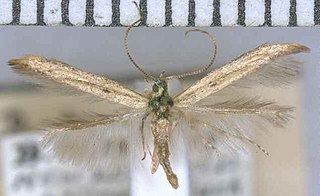
Eupithecia innotata, the angle-barred pug, is a moth of the family Geometridae. The species was first described by Johann Siegfried Hufnagel in 1767. It ranges from Spain in the west to western Siberia and Central Asia in the east.

Orthonama obstipata, the gem, is a moth of the family Geometridae. The species was first described by Johan Christian Fabricius in 1794. It is a cosmopolitan species. In continental Europe though in the northeast, its range does not significantly extend beyond the Baltic region and it is absent from northern Russia. This well-flying species is prone to vagrancy and able to cross considerable distances of open sea; it can thus be regularly found on the British Isles and even on Iceland.

Ichneutica mutans, commonly known as the New Zealand cutworm or the grey-brown cutworm, is a moth of the family Noctuidae. This moth endemic to New Zealand and can be found throughout New Zealand, including from Three Kings Islands down to Stewart Island. However this species is not found in the Chatham Islands. The adult moths are on the wing all year round. I. mutans is variable in appearance and can be confused with similar species in the same genus. As a result of the variety of host species consumed by the larvae of the species, including such crops as turnips, wheat and apples, this species is regarded as an agricultural pest. However between the early 1960s and late 1980s the population of I. mutans was shown to have decreased significantly, by over 80%, at two study sites.
Bacotoma is a genus of moths in the subfamily Spilomelinae of the family Crambidae. It currently comprises 11 species, with an Oriental and Australasian distribution ranging from India and Sri Lanka over China and Southeast Asia to Australia.

Scirpophaga is a genus of moths of the family Crambidae described by Georg Friedrich Treitschke in 1832. Asian species include significant rice stemborer pests.

Arsacia is a monotypic moth genus of the family Noctuidae. Its only species is Arsacia rectalis. Both the genus and species were described by Francis Walker, the genus in 1866 and the species in 1863. It is found from the Indo-Australian tropics of India, Sri Lanka to Queensland and the Solomon Islands.

Nigetia is a monotypic moth genus in the family Erebidae. Its only species, Nigetia formosalis, the thin-winged algibelle or thin-winged owlet moth, has a scattered distribution in eastern North America from Ontario to Connecticut, south to Florida and Texas. Both the genus and the species were first described by Francis Walker in 1866.

Cingilia is a monotypic moth genus in the family Geometridae erected by Francis Walker in 1862. Its only species, Cingilia catenaria, the chain-dotted geometer, chain dot geometer, chainspotted geometer or chain-spotted geometer, was first described by Dru Drury in 1773. It is found in North America from Nova Scotia south to Maryland and west to Kansas and Alberta.

Ichneutica insignis is a moth of the family Noctuidae. It is endemic to New Zealand. This species is found throughout New Zealand, although it appears to be scarce in inland sites of tussock grasslands. The adults are on the wing throughout the year. It is a variable species and as such can be easily confused with I. skelloni and I. plena. The larvae of this species have been recorded as feeding on Trifolium pratense.

Zermizinga is a moth genus in the family Geometridae erected by Francis Walker in 1863. Species within this genus include Zermizinga sinuata, the lucerne looper or spider moth, which was described by Warren in 1897, as well as Zermizinga indocilisaria, which was described by Walker in 1863.

Scirpophaga innotata, the rice white stemborer, is a species of moth of the family Crambidae. The species was described by Francis Walker in 1863. It is found in Indonesia, Pakistan, the Philippines and the tropical north of Australia.

Aseptis binotata, the rusty shoulder knot moth, is a moth of the family Noctuidae. The species was first described by Francis Walker in 1865. It is found widespread in western North America, west of south-central Alberta, Wyoming, and Nebraska. Along the Pacific Coast it occurs from northern Mexico to south-central British Columbia. It can be found from sea level to altitudes over 2000 meters in a variety of habitats from dense forest to shrub desert.

Batrachedra arenosella, the armoured scale eating caterpillar or the coconut moth, is a species of moth of the family Batrachedridae. It was first described by Francis Walker using specimens collected in Auckland, New Zealand. It has been hypothesised that the New Zealand moth may contain two distinct species. As well as the moth species in New Zealand, this name has been applied, perhaps incorrectly, to moths found in India, Indonesia, the Malay Peninsula, and Réunion, as well as in Australia, from the Northern Territory and northern Queensland to New South Wales and South Australia.

Synemon is a genus of moths within the family Castniidae. It was described by Edward Doubleday in 1846. The genus contains 24 described and 20 undescribed species. These species are found across mainland Australia and on Kangaroo Island, with the highest diversity in Western Australia. Synemon species can be found in a range of habitats, including woodlands, heathlands and native perennial grasslands. The adults fly during the daytime in warm to hot weather. They have clubbed antennae, and are often mistaken for butterflies.

Musotima nitidalis, also known as the golden brown fern moth, is a species of moth of the family Crambidae. This species was described by Francis Walker in 1866. It is native to Australia and New Zealand and was first found in Europe in 2009.

Gesonia obeditalis is a species of moth of the family Noctuidae first described by Francis Walker in 1859. It is found from eastern Africa, the Seychelles, the Maldives and the Oriental tropics of India, Myanmar, Sri Lanka east to the Philippines, the Sula Islands and Australia. The adult moth has brown wings with a scalloped dark brown band near the margin. The hindwings are similar in pattern to the forewings but are a paler shade of brown.

Ichneutica nullifera is a moth of the family Noctuidae. This species is endemic to New Zealand and can be found in the Tongariro National Park, along the Wellington coast and throughout the South Island. The adults are large and the forewing of adults can vary in colour from pale fawn to dark grey. The larvae are coloured a bright yellow-brown with a paler underside. The larval host species are in the genus Aciphylla and as a result the adult moths are often found in habitat dominated by species in this genus. Adults are on the wing from November to early April and are sometimes attracted to light.
Strepsicrates semicanella is a species of moth of the family Tortricidae first described by Francis Walker in 1866. It is found in south-east Asia and in New Caledonia, Australia and Japan. The habitat consists of alluvial forests.
Scirpophaga nivella is a moth in the family Crambidae. It was described by Johan Christian Fabricius in 1794. It is found in southern Asia from the Indian Subcontinent in the west to southern China in the east, south to New Guinea and Australia, including New Caledonia and Fiji. Some sources have affixed the common name "sugarcane top borer" to it, despite it not being found in sugarcane, because they are confused with the species Scirpophaga excerptalis, which is an actual borer in the tops of sugarcane. Another newer common name that has been invented for these moths is "white rice borer".
Agrioglypta excelsalis is a moth in the family Crambidae described by Francis Walker in 1866. It is found on Sulawesi, Lifou Island, as well as in Bhutan, Thailand, Sumatra, Papua New Guinea, Samoa and in Australia, where it has been Western Australia, Queensland and northern New South Wales.
















